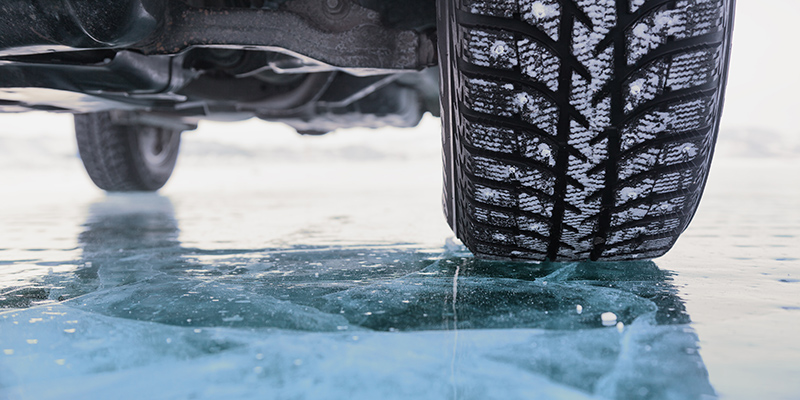Winter tires: Switching in time
- 10/05/2020
- Created by Christian Kubik, TÜV AUSTRIA Automotive
The special grip properties of the good winter tire are already valuable and important in the fall, when night temperatures fall, frost on road bridges and on roads in wooded or exposed areas, and at the first snowfall.
Winter tire requirement
In Austria, winter tyres are legally required for cars and trucks up to 3.5 t in the period from 01 November to 15 April and in winter road conditions, especially snow, slush or ice. These vehicles may then only be put into operation if winter tires are fitted to all wheels.
The obligation to use winter tires also applies to trucks over 3.5 t and buses, but sometimes in shorter periods and with different technical requirements (for example, winter tires on the wheels of a driving axle are sufficient, but the winter tires must generally be fitted within the applicable period).
Attention: the obligation to use winter tires on passenger cars has been extended to four-wheeled light vehicles with closed, cab-like bodies (so-called microcars).
What is often forgotten: in addition to the correct marking ("M+S", "M.S." or "M&S" (since the end of 2018, tire models marked with the snowflake symbol (mountain pictogram with snowflake) are also considered winter tires), a winter tire is only considered a winter tire if it has a tread depth of at least 4 mm for radial tires (the most common type of tire) for passenger cars and 5 mm for trucks (>3.5t).
With a lower tread depth, it is then considered a summer tire and may then be "used up" in summer - which is clearly not optimal, however, due to the longer braking distance of the tire designed for cold temperatures.
Use of snow chains
As an alternative to winter tires, it is also permissible to use snow chains if the road surface is covered with a continuous or not significantly interrupted layer of snow or ice. With regard to snow chains, we recommend that before the winter season and in peace and quiet and in accordance with the manufacturer's instructions, a (trial) installation be carried out so that then, in the required situation, rapid and above all safe action can be taken.
And don't forget: snow chains are suitable for a certain range of applications, i.e. for a certain range of wheel/tire dimensions. So if you convert your vehicle to another wheel/tire dimension, please do not forget to look for the right snow chain.
Use only tested snow chains that are suitable for your vehicle / wheel/tire combination - the KFG still clearly prescribes wheel slide protection devices tested according to ÖNORM. Important in case of liability with the insurance.
All-Season Tires
From the point of view of TÜV AUSTRIA, the use of all-season tires can be useful, especially in the eastern conurbations of Austria, in urban areas and rather also for vehicles with less annual mileage, if you can leave the vehicle at home on days with pronounced winter road conditions. For all technical developments, including all-season tires, almost all test results - whether on dry, wet and especially snow-covered roads - show measured braking distance extensions of approx. + 20% in some test constellations.
Check tire pressure
Changing tires is also a good opportunity to read up on how to set the correct tire pressure for the respective vehicle - front and rear axle - in the operating manual. It is widely known that too little air pressure can lead to increased fuel consumption and higher CO2 emissions - but here, too, the braking distance is at risk of deteriorating.
Safety from a single source
The experts at TÜV AUSTRIA Automotive are happy to advise on all aspects of vehicle conversion. On request, we will handle the necessary vehicle inspection, the preparation of the test report and the complete registration procedure of the changes in the vehicle documents with the responsible authorities for you.
Tire change checklist
Tire age: Every tire changes with age and wear and tear, also its grip properties. The recommendations of the VRÖ - Verband der Reifen-Spezialisten Österreichs (Association of Austrian Tire Specialists) must be observed. Tire dealers have appropriate information material. Specialist dealers can also check the age of the tire or can determine the age of the tire themselves using the codes indicated on the tire sidewall (e.g. 'DOT 0820' = "08", 8th week of the year "20", 2020. This is then the date of manufacture of the tire).
Always tighten the wheel nuts/wheel bolts to the tightening torque specified by the vehicle manufacturer for the respective type of rim (aluminium or steel). The vehicle or tire dealer knows the correct technical values.
Caution: when changing the wheels from summer to winter, some wheel nuts/bolts may be damaged.
Perform a test drive after changing the wheels and check the wheel nuts
Fill in correct tire pressure according to vehicle manufacturer's specifications
Choose a suitable storage place for the dismantled summer tires (ideal conditions are cool, dark. Store the tires inflated with a slightly higher inflation pressure (approx. + 0.5 bar)
Break in new tires a little bit, so they can build up full grip
TÜV AUSTRIA Automotive | Motor Engineering & Traffic
Deutschstrasse 10 1230 Vienna | +43 5 0454-6438 | automotive(at)tuvaustria.com | tuvaustria.com/automotive
[Translate to English:] Winterreifen: TÜV AUSTRIA Expertentipps 2020 (C) Shutterstock, Albina Tiplyashina
Winter tires: TÜV AUSTRIA experts give tips

